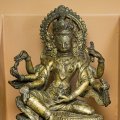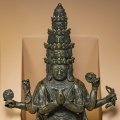Patan Museum (Nepal): photo 57
Photo 57 of 212 in Gallery: Patan Museum (Nepal)

Image title: Shiva and Parvati (Nepal, 18th century)
Description of the photo
This Copper sculpture shows an image of Shiva and Parvati, from the 18th century origination from Nepal.—Materials used: Copper, gilt, paint.
Description: Five faces express more aspects of personality than one and ten arms enable the god to caress his consort, display symbolic hand poses, and hold attributes suitable to his character. The multiple faces and attribute-holding hands also provide a greater number of clues by which the image can be identified.
Notes: Why do gods have multiple heads and hands? In the later development of Hindu and Buddhist practice, known as Tantrism or, in Vajrayana Buddhism, “The Way of the Thunderbolt”, deities are given multiple heads and limbs to better express their complex personalities and their multiple functions.
Gallery information:
The Patan Museum is located on the Durbar square of Patan (Lalitpur/Lalitapura, Kathmandu, Nepal) which is associated Keshav Narayan Chowk (Keshavnarayan)—a form of Lord Vishnu. Being listed as a World Heritage Site, the whole of Durbar square is filled with exquisite temples, sculptures and other ancient structures, of which the ancient history history can be traced to the Malla Kings of Lalitpur. It is an important site for both Buddhism and Hinduism.
Photo details:
Date: 2019-12-02
Camera: SONY ILCE-6400
Exposure: 1/25
Aperture: f/4
ISO: 100
Focal length: 18mm
High resolution:
Download file
Size: 3.56 MB
Resolution: 2118 x 2982
© Photograph by Gabe Hiemstra.
License: CC BY-NC-ND 4.0

